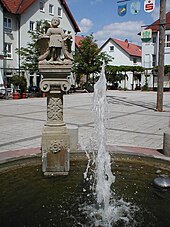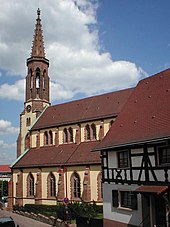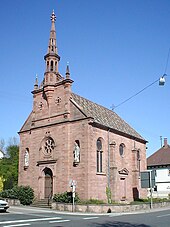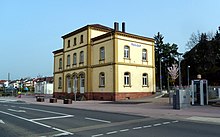Waibstadt
| coat of arms | Germany map | |
|---|---|---|

|
Coordinates: 49 ° 18 ' N , 8 ° 55' E |
|
| Basic data | ||
| State : | Baden-Württemberg | |
| Administrative region : | Karlsruhe | |
| County : | Rhein-Neckar district | |
| Height : | 172 m above sea level NHN | |
| Area : | 25.57 km 2 | |
| Residents: | 5682 (December 31, 2018) | |
| Population density : | 222 inhabitants per km 2 | |
| Postal code : | 74915 | |
| Area code : | 07263 | |
| License plate : | HD | |
| Community key : | 08 2 26 091 | |
| LOCODE : | DE WBD | |
| City structure: | 2 districts | |
City administration address : |
Hauptstrasse 31 74915 Waibstadt |
|
| Website : | ||
| Mayor : | Joachim Locher (independent) | |
| Location of the city Waibstadt in the Rhein-Neckar district | ||
Waibstadt is a town with around 5700 inhabitants in the Rhein-Neckar district in Baden-Württemberg . It belongs to the European metropolitan region of Rhine-Neckar (until May 20, 2003 the Lower Neckar region and until December 31, 2005 the Rhine-Neckar-Odenwald region ). The city belongs to the municipal administration association Waibstadt and the tourism region Brunnenregion .
geography
Location and natural space
Waibstadt is located in the Schwarzbachtal in the northern Kraichgau , about 20 km southeast of Heidelberg and about 6 kilometers north of Sinsheim .
The district extends over 2557 hectares. Of this, 15.1 percent is settlement and traffic area, 54.1 percent is used for agriculture and 29.6 percent is forested.
The 60 hectare "Waibstädter Schwarzbachaue" is a natural valley floodplain with wet biotopes and meadows as well as an orchid meadow , which has five species of orchids found in Germany, under nature protection . The Zwärenbrüchle in Daisbach is classified as an extensive natural monument. Waibstadt also has a share in the landscape protection areas Neckarbischofsheimer Höhen, a typical landscape of the Kraichgau hill country, and Elsenztal, which belong to the Neckartal-Odenwald nature park .
Neighboring communities
The city borders in the northwest on Neidenstein , in the northeast on Helmstadt-Bargen , in the east on the city of Neckarbischofsheim , in the south on the city of Sinsheim and in the west on Zuzenhausen and Eschelbronn .
City structure
The city of Waibstadt consists of the two districts Daisbach and Waibstadt. The districts are spatially identical to the earlier communities of the same name.
The Ursenbacherhof homestead (formerly Bleihof) belongs to the Daisbach district . The Bernau settlement and other repatriate farms belong to the Waibstadt district .
history
Until the 18th century
There are indications that there was a Roman settlement in the area around the city as early as Roman times. Evidence is provided by a votive stone found in the 17th century , which served as a holy water font in the Catholic parish church until 1882 and was later brought to the grand ducal collection in Karlsruhe.
In 1988 a large basement room was discovered in a field. This probably belonged to a villa rustica . It is estimated that it was about to see an Vikus or camp village that along with located in the vicinity estates for one am Neckar Limes situated castle produced agricultural products.
The first documentary mention as a woman's act was in the year 795 in the Lorsch Codex . During the Franconian era, Waibstadt was fortified with defensive towers and a city wall and around 1200 the Hohenstaufen gave it city rights and, in this context, with the imperial privilege, the status of a “Free Imperial City”. In 1241 Waibstadt was mentioned as a free imperial city in the imperial tax register. The town and all documents were destroyed by a town fire, whereupon the town charter was confirmed by Emperor Ludwig IV in 1347, following the example of Wimpfen .
For most of its history Waibstadt was pledged by the Kaiser, first to the Speyer Monastery , then to the Lords of Helmstatt and for a long time to the Electoral Palatinate . During this time, several mansions were built that are still preserved today and are inhabited by private owners. From the 17th century onwards, the deposit was back with Speyer. In 1608 the barons of Degenfeld acquired a noble estate in Waibstadt. The three-story, plastered baroque building with turrets under the name "Degenfeld MOORISH Schlössle 'known. During the Thirty Years War hit Tilly his headquarters in Waibstadt on. The After the Peace of Westphalia , the city tried repeatedly without success to trigger itself and again reichsunmittelbar to be. The last Trial lasted until 1774.
19th and 20th centuries
The city fortifications were partly removed in the 17th century and finally in the 19th century. In 1803 Waibstadt came to Baden and became the seat of its own office. It was dissolved again in 1810 and the city was assigned to the Neckarbischofsheim district office . From 1857 Waibstadt belonged to the Sinsheim district office . After a major fire in 1889, Grand Duke Friedrich I visited the city.
In 1950 the town charter was formally reassigned. On July 1, 1971 Daisbach was incorporated. In the course of the Baden-Württemberg district reform , the district of Sinsheim was dissolved in 1973 and the city was incorporated into the newly formed Rhein-Neckar district. In 1975 the Waibstadt Municipal Administration Association was founded. The growth of the city was accompanied by infrastructure measures such as the construction of the secondary school, a sports and swimming pool and the expansion of the city hall. In 1987 for the first time more than 5000 inhabitants were counted in Waibstadt.
Population development
The following list summarizes the inhabitants in the current territorial status and is based on the census results or their official updates.
| year | 1871 | 1910 | 1939 | 1950 | 1961 | 1970 | 1980 | 1990 | 1995 | 2001 | 2005 | 2010 | 2015 | 2018 |
|---|---|---|---|---|---|---|---|---|---|---|---|---|---|---|
| Residents | 2563 | 2554 | 2402 | 4002 | 3899 | 4696 | 4840 | 5268 | 5600 | 5751 | 5736 | 5723 | 5735 | 5682 |

Religions
In keeping with their affiliation with Speyer, the vast majority were Catholic for a long time. In 1933 the Catholics made up 91.7 percent of the population. Today the Catholic parish belongs to the Kraichgau Dean's Office of the Archdiocese of Freiburg . The Protestant parish, officially established in 1920, belongs to the Kraichgau church district of the Evangelical Church in Baden . It is therefore one of the youngest parishes of the Evangelical Church in Kraichgau.
Some Jews have lived in Waibstadt since the Middle Ages . The 233.32 ares large Jewish cemetery was built after the Thirty Years War and with 2556 known tombstones is one of the largest Jewish cemeteries in Baden. By 1860 the cemetery was responsible for 80 Jewish communities. The highest level of the Jewish population in Waibstadt was reached in 1884 with 67 Jewish inhabitants. Then there was a strong migration. The synagogue, built in 1847, was last used in 1925 and sold to a private citizen in 1938, avoiding the destruction of the November pogroms in 1938 . The building was initially used as a tobacco shed and later as a storage room. In 1977 the building was demolished because it was in disrepair. Today the property serves as an undeveloped parking space. There is no memorial stone.
During the deportations during the Nazi era , at least three of the eight Jews living here in 1933 were killed. In 2012, the artist Gunter Demnig laid a total of seven stumbling blocks in front of the houses of the displaced Jewish population. Since 2010 a memorial on the market square has been commemorating the deportation to the Gurs concentration camp . The memorial is part of the central memorial in memory of the deported Baden Jews in Neckarzimmern.
politics
Municipal council
The municipal council consists of 14 members and is elected directly every five years. In doing so, the false choice of suburbs in the sense of the Baden-Württemberg municipal code guarantees that eleven councilors are provided by the Waibstadt district and three by Daisbach. The mayor is the voting chairman of the municipal council. In addition, Daisbach has its own local council with a local mayor as its chairman.
The 2019 local elections led to the following result (in brackets: difference to 2014):
| Municipal Council 2019 | ||||
|---|---|---|---|---|
| Party list | Share of votes | Seats | ||
| Joint list of CDU and voter group | 45.8% (−2.3) | 6 (−1) | ||
| Waibstadt community of voters | 41.1% (+4.9) | 6 (+1) | ||
| SPD | 13.0% (−2.8) | 2 (± 0) | ||
mayor
The mayor is directly elected for eight years. In the 2009 election, Joachim Locher won with 97.72 percent of the vote. On May 14, 2017, Locher was re-elected with 98.33 percent of the vote. The turnout was 44.00 percent.
Previous community leaders:
|
|
coat of arms
The blazon of the coat of arms reads: In gold, a red armored and red-tongued black eagle. The coat of arms goes back to a seal from 1337. It shows the imperial eagle usual for imperial cities. The flag is black and yellow and was awarded by the Interior Ministry in 1962.
Town twinning
The political community has no town twinning. The Catholic parish has had a friendly relationship with the Catholic parish in Villa el Salvador, a district in southeast Lima, since 1989. Every year a benefit event 'One Day for Peru' takes place in the city hall of the city. A day hospital with its own laboratory and pharmacy could be financed through the large amount of donations from the population of Waibstadt. The project is supported by the political community.
Buildings
The landmark of the place is the "Brunnenweible", a fountain figure reconstructed after the Second World War, which, according to legend, was donated by a German emperor in the 12th century as thanks for a successful hiding place in Waibstadt.
The neo-Gothic Catholic parish church of Our Lady from 1868, whose tower towers far above the Altort, is considered the tallest church building in the Kraichgau. The 65 m high tower is made of red sandstone typical of the front Odenwald region. The center of the church are the three choir windows created by Valentin Peter Feuerstein in 1962, predominantly in red and blue tones. In 1958, the Frankfurt sculptor Franz Bernhard created the scenes of the Cross in terracotta from reddish clay as half-relief panels. Inside the church there is also a historic pulpit that was donated by the Counts of Helmstatt .
The Marienkapelle "Maria, Rosenkranzkönigin" is also built entirely from red sandstone. On the hill behind the chapel there is still the neo-Gothic Evangelical Church from 1910. During a restoration in 2010, the blue sky, decorated with gold stars, was exposed again in the chancel.
The artist Marie Ellenrieder was to create a "7 shoe high and 4 ½ wide" image of the Virgin Mary for the Catholic parish church. The painting remained unfinished, however, as Marie Ellenrieder died before completion in 1863. It is considered one of her last works. In the Marienkapelle a small replica reminds of the unfinished work of art. The original painting with the title "Maria mit dem Jesuskind" is in Konstanz in the municipal Wesenberg-Galerie Konstanz .
On the Mühlberg outside the former city wall, the tabernacle-like, baroque, sandstone-built “Mühlberg Chapel” has stood since 1745. In 1912 the three sides of the originally open chapel were bricked up. Inside the chapel there is the miraculous image of the Schoenstatt Madonna . Until the 1950s there was a painting of the Mount of Olives inside . The chapel was to become part of a way of the cross . However, this was not completed. It is assumed that the chapel is the successor to the former St. Sebastian chapel. This was already mentioned as a chapel standing outside the city wall on a hill in the Worms Synodal (1496).
Next to the former elementary school building, built in 1896 (architect was Otto Ehrmann ), which today houses the city library, there is a chapel dedicated to St. Anthony of Padua . The predecessor of today's chapel was built as early as 1825, probably in the course of the city's expansion and the relocation of the cemetery outside the city wall. In 1906 today's baroque, Gothic and Neo-Renaissance chapel was built. It is used as an altar for the second station during the annual Corpus Christi procession .
In the center of the village there are numerous half-timbered houses and historic farmsteads, as well as rural properties and commercial buildings along the local road, such as the historic brewery and restaurant "Adler" near the parish church and the former confectionery from 1908.
A three-story, plastered baroque building with turrets, built by the Lords of Degenfeld , is built directly onto the former city wall . Below the manor house is a former property with an associated manor house belonging to the von Helmstatt family. Only a few remains of the city fortifications from the 14th century have survived.
There are several historical crucifixes, statues of Mary and saints u. a. John of Nepomuk and Antonius of Padua received. Crosses date from 1736 and 1829, among others, and there is also a nearly life-size Maria Immaculata and a historical St. Mary's altar. The statue of St. John of Nepomuk was destroyed by unknown people during World War II. After the war, the remains of the statue were found in nearby Schwarzbach . In the 1970s, the statue was restored by citizens and local companies and placed back in its traditional place on the bridge over the Schwarzbach.
The large Jewish cemetery to the east above the village was laid out after 1648 and was an association cemetery for up to 19 Jewish communities in the area. And situated directly at the cemetery mausoleum of Hermann Weil was built from 1924 to 1927. It was named " Monument of the Month May 2010" by the Monument Foundation Baden-Württemberg .
In the Daisbach district are the ruins of the Daisbach Castle , which was first mentioned in 1366 as a property of the Lords of Venningen , destroyed by fire in 1627 and partially rebuilt in 1730. The town council has been restoring the ruins since 1991.
Old mansion of the barons of Degenfeld
Hermann Weil mausoleum
Economy and Infrastructure
traffic
Waibstadt is located directly on federal highway 292 . Via this one reaches the federal highway 6 , junction Sinsheim, seven kilometers away .
Waibstadt is located on the Schwarzbachtalbahn ( Meckesheim - Aglasterhausen ), which is integrated with the S 51 into the network of the RheinNeckar S-Bahn . This means that connections to Heidelberg and Mannheim are free of charge . In addition, the city is connected to Sinsheim and Mosbach / Neckarelz by bus lines . Waibstadt belongs to the tariff area of the Rhein-Neckar transport association .
The Kraichgau-Stromberg Castle Tour runs through Waibstadt , an approximately 52-kilometer regional cycle route that connects the town with the communities of Neidenstein and Neckarbischofsheim.
Established businesses
In Waibstadt there is a production facility of the company riha WeserGold Getränke . The bus transport company PalatinaBus GmbH has been operating a location in Waibstadt since 2010 .
media
The Rhein-Neckar-Zeitung reports on local events . The newsletter of the Waibstadt municipal administration association appears weekly.
Authorities and institutions
Waibstadt is the seat of the municipal administration association Waibstadt, to which Epfenbach, Helmstadt-Bargen, Neckarbischofsheim, Neidenstein and Reichartshausen belong. Until mid-2009, he operated a nursing home in the former Waibstadt municipal hospital. Furthermore, the seat of the special purpose association for flood protection "catchment area Elsenz - Schwarzbach " is located in Waibstadt .
Until 2007, the city was the seat of the Waibstadt dean's office. After the reform of the deanery in 2008, the Kraichgau deanery of the Archdiocese of Freiburg was created from the pastoral care units Bad Rappenau / Obergimpern, Eppingen, Neckar-Elsenz, Sinsheim-Angelbachtal and Waibstadt .
One of the weather stations of the German Weather Service is located in Waibstadt .
education
There is a primary school and a Protestant kindergarten in Daisbach. In Waibstadt there is the well school (elementary school) and a secondary school as well as the municipal kindergarten and the Catholic kindergarten St. Josef. Secondary schools can be attended in Neckarbischofsheim (grammar school) and Sinsheim (grammar school and vocational schools) as well as in Epfenbach and Helmstadt (comprehensive school). Since 2011 the non-profit association "Kinderkrippe Rappelkiste eV" has been running a daycare center in Waibstadt. The city operates libraries in Daisbach and Waibstadt and an indoor and outdoor pool in the Waibstadt district.
Personalities
Honorary citizen
- Alexander Wacker (1846–1922), founder of the Wacker works
- Karl Eiermann (1912–1991), Mayor (1958–1978) and CDU district councilor
- Sister Superior Avellina (1902–1995), nun of the " Sisters of St. Joseph ", head of the city hospital for 30 years
sons and daughters of the town
- Quirin Metzger (1498–1551), later canon of Speyer
- Jakob Ernfelder (1544–1601), Jesuit , Provincial of the Rhenish Order Province
- Carl Gottfried von Degenfeld (1690–1727), co-lord of Wagenbach, to Waibstadt, Unterbiegelhof and Ehrstädt, lieutenant in the Palatinate regiment of Prince von Sulzbach
- Paul Egell (1691–1752), sculptor and plasterer
- Otto Ehrmann (1851–1928), architect
- Mathias Götz (* 1972), jazz musician
- Georg Steinberg (* 1974), legal scholar
People who worked on site
- Emil Stehle (1926–2017), bishop of the Ecuadorian diocese of Santo Domingo de los Colorados . (From 1953–1955 chaplain in Waibstadt)
- Karl Burger (1883-1959) was a German football player . (inter alia 1945 acting mayor and owner of a restaurant with cinema)
literature
- 1200 years Waibstadt: Contributions to the history of the formerly free imperial city . Waibstadt 1995
- Adolf M. Hirn, Gabriele Süskind (ed.), Jürgen Schütz (ed.): The Rhein-Neckar district . Stuttgart 1991, ISBN 3-8062-0597-3 .
- Alfred Kimmelmann: History of a pledged, formerly free imperial city. Karlsruhe 1936
Web links
Individual evidence
- ↑ State Statistical Office Baden-Württemberg - Population by nationality and gender on December 31, 2018 (CSV file) ( help on this ).
- ↑ State Statistical Office Baden-Württemberg, status: December 31, 2004 ( page no longer available , search in web archives ) Info: The link was automatically marked as defective. Please check the link according to the instructions and then remove this notice.
- ^ State Institute for Environment, Measurements and Nature Conservation Baden-Württemberg
- ^ The state of Baden-Württemberg. Official description by district and municipality. Volume V: Karlsruhe region Kohlhammer, Stuttgart 1976, ISBN 3-17-002542-2 , pp. 416-417.
- ↑ Minst, Karl Josef [trans.]: Lorscher Codex (Volume 4), Certificate 2590, May 29, 795 - Reg. 2509. In: Heidelberger historical stocks - digital. Heidelberg University Library, p. 178 , accessed on February 19, 2016 .
- ^ Federal Statistical Office (ed.): Historical municipality directory for the Federal Republic of Germany. Name, border and key number changes in municipalities, counties and administrative districts from May 27, 1970 to December 31, 1982 . W. Kohlhammer, Stuttgart / Mainz 1983, ISBN 3-17-003263-1 , p. 479 .
- ↑ Baden-Württemberg State Statistical Office
- ↑ Working group for research into the history of the Jews in southern Germany and neighboring areas: Waibstadt
- ^ State Statistical Office of Baden-Württemberg: Municipal elections 2019, City of Waibstadt ; City of Waibstadt: City Council Election 2019 (PDF) ; accessed May 31, 2019.
- ^ City of Waibstadt - Mayor then and now. Retrieved March 30, 2020 .
- ^ Herwig John, Gabriele Wüst: Wappenbuch Rhein-Neckar-Kreis . Ubstadt-Weiher 1996, ISBN 3-929366-27-4 , p. 121.
- ^ Assumption of the Virgin Mary, Waibstadt. Retrieved February 8, 2020 .
- ↑ Kraichgau-Stromberg: Castle Tour | Vacation country Baden-Wuerttemberg. Retrieved June 21, 2020 .
- ^ City of Waibstadt - Waibstadt time table. Retrieved February 8, 2020 .
- ↑ Waibstadt light games - Kinowiki. Retrieved April 21, 2020 .




















